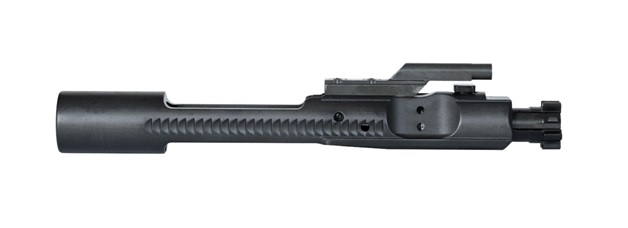Bolt Carrier Breakdown: A Short Guide to Different Coatings
May 23rd 2023
If you build an AR-15 (or some other AR-style platform), the AR 15 parts kit you build it from might come with everything you need except a lower receiver blank.
Then again, there are some common parts that are routinely (and conspicuously) absent from parts kits. Some of the more common parts omitted include pistol grips, magazines, and bolt carrier groups, or BCGs.
In other instances, where the BCG is included, it is a mil-spec, phosphate coated model - which, for some shooters, is not appealing.
This post will cover some of the different coatings that are available for modern BCGs and how the impact the build’s performance.
The Beating Heart of Your Rifle
The bolt carrier group is one of the most important parts of your rifle and it pays to take a little extra consideration when pairing one with your build.
The bolt carrier group houses the gas rings, cam pin, firing pin, firing pin retaining pin, extractor, and ejectors, all of which work together and are responsible for feeding, firing, extracting, ejecting, and siphoning potential energy in the form of capturing propellant gases to cycle the action.
Every AR-style rifle, and others with gas impingement systems, need a bolt carrier group, but not all are created equal. They are made with a wide variety of modern coatings that improve permanent dry lubricity, corrosion, and wear resistance, and more. These are some of the most common among BCG coatings.
Phosphate Coated
“Everyman’s” AR-15 has a phosphate-coated BCG. This is a crystalline coating applied to ferrous metals to inhibit corrosion. It has a dull, matte-black coloration, and current mil-spec for BCGs (for the M16) requires a phosphate coating.
Phosphate coatings are affordable and do a decent job of protecting the BCG against wear and corrosion, and since they have a matte finish are non-reflective, which is a decided benefit in a combat environment.
However, due to the fact that phosphate coatings have a slight “tooth” they require a little more liquid lubricant to run smoothly and can trap dirt, fouling, and dust that can accelerate wear.

Hard Chrome
The first AR-15 rifles were made with hard chrome bolt carrier groups. Slightly more expensive than a phosphate coating, a hard chrome BCG offers greater corrosion resistance, and since it has a smooth surface, requires less liquid lubrication and is easier to wipe clean.
They are also a shiny silver color, an aesthetic that some shooters prefer.
Black Nitride
Black nitride coatings, which are also sometimes referred to simply as “nitride” coatings, are a great all-around alternative to phosphate coatings.
A black nitride coating is applied through a careful heat treatment process that deposits nitrogen onto the surface of the steel bolt carrier group. It is impossible to chip or flake off and is very hard and corrosion-resistant.
A nitrided bolt carrier group has another significant advantage. It has what is called superior “permanent dry lubricity.”
That is, it has a surface that is very slick and very smooth. They require less liquid lubrication to operate smoothly, and since they are naturally corrosion-resistant, even less can be used. This trait also makes it easier to wipe them clean as fouling will not stick as efficiently to the surface of a nitrided BCG.
For builders looking to outfit their rifle with a “tactical black” BCG, black nitride is a good option. Though it can be more expensive than a phosphate coating, black nitride has a shiny black aesthetic that offers superior performance, too.
Nickel Boron
Nickel boron-coated bolt carrier groups look like hard chrome BCGs, but they are actually produced through an electroless plating process that leaves a finish on the surface of the BCG that is 95% nickel and 5% boron.
Nickel boron, or NiB, coatings are fairly expensive, but they are extremely corrosion and wear-resistant. They are also extremely hard and with such a smooth surface, they are also fairly easy to clean.
This is another unique feature of NiB: enhanced permanent dry lubricity, that, like nitride coatings, is naturally slick and requires minimal liquid lubrication, keeping the bolt cleaner for longer.
Titanium Nitride
Last but not least we have titanium nitride, which is a coating that is actually composed of an extremely hard ceramic material that improves durability, surface hardness, corrosion resistance, and of course, permanent dry lubricity.
This coating is popular for the fact that it is hard and durable, as well as for its superior permanent dry lubricity that enables the shooter to keep use of liquid lubrication to a minimum. However, one of the main reasons for its popularity has got to be looks: TiN coatings are an eye-catching gold.
With that said, one of the potential drawbacks of a titanium nitride coating is cost, as they are more expensive than many other BCG coatings.

Talk to Us Before Buying an AR 15 Parts Kit
Whether you’re going to assemble an AR from a parts kit or build a brand new, customized rifle with an AR 15 parts kit and a receiver blank, we have the parts and knowledge you need to finish the job. If you have any questions about different AR-15 parts or BCG coatings or would like to lean on our experience, either visit us in our showroom at 50 Hilton Street in Easton, Pennsylvania or call us at 610-250-3960.

